More research highlights
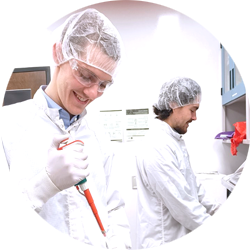 A fast, portable and versatile biosensor developed by technology start-up DeteXion could enable diseases to be diagnosed more effectively, thanks to an innovative optical breakthrough. An original solution stemming from a northern issue, and that could soon have a global societal impact.
A fast, portable and versatile biosensor developed by technology start-up DeteXion could enable diseases to be diagnosed more effectively, thanks to an innovative optical breakthrough. An original solution stemming from a northern issue, and that could soon have a global societal impact.
Technological maturation at the heart of Sentinel North's innovative ecosystem
As part of the Sentinel Microbiomes project, physics master's student Louis-Philippe Dallaire and his supervisor Claudine Allen designed a robust, portable instrument for rapid field detection of picocyanobacteria in Arctic lakes.
The team then benefited from Sentinel North's Maturation Fund with the aim of commercializing the technology, envisaging its use to facilitate the monitoring of drinking water quality in the North.
This crucial phase of maturation and technological incubation enabled DeteXion instigators Louis-Philippe Dallaire and Jérémie Guilbert to advance their project and win a series of grants (EGGENIUS and Mitacs accélération), in addition to concluding partnerships with TransBIOTech and Quantino.
 Culturally appropriate diets offer a new route to food security in the Canadian Arctic, according to research by Tiff-Annie Kenny, Professor in the Department of Social and Preventive Medicine at Université Laval.
Culturally appropriate diets offer a new route to food security in the Canadian Arctic, according to research by Tiff-Annie Kenny, Professor in the Department of Social and Preventive Medicine at Université Laval.
An unprecedented, multifaceted public health crisis
As sea ice recedes, permafrost thaws and extreme weather events multiply, access to traditional hunting and fishing grounds is becoming increasingly difficult. Exposure to contaminants and the introduction of Western dietary patterns in Arctic regions have added to the factors that have accelerated the prevalence of health issues linked to food insecurity in the Inuit population.
But there are solutions that include culturally appropriate food systems to ensure access to affordable, nutritious, safe and preferred foods. These solutions can inspire Inuit-specific actions to prevent the development of food-related diseases and food insecurity.
To find out more, read the full article in The Conversation.
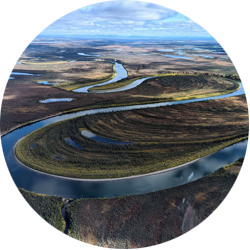 An international research team led by Sentinel North’s chairholder Pascale Roy-Léveillée has observed that the migration of large Arctic sinuous rivers in permafrost terrain has slowed down by about 20% over the past half century.
An international research team led by Sentinel North’s chairholder Pascale Roy-Léveillée has observed that the migration of large Arctic sinuous rivers in permafrost terrain has slowed down by about 20% over the past half century.
(Ielpi and al., 2023).
Defying predictions: convergence research to go beyond expected ideas
Many scientists have predicted that the lateral migration of northern rivers could be accelerated by bank destabilization and erosion caused by thawing permafrost. However, the team led by Prof. Roy-Léveillée was surprised to find that northern rivers are not moving as predicted by models as a function of regional warming. The team made this observation while monitoring the impact of climate change on the major rivers of the Canadian Arctic and Alaska. This unexpected discovery could have important implications for watershed-scale carbon budgets and climate feedback.
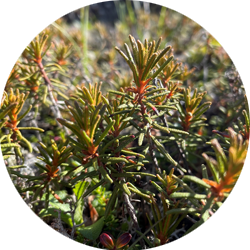 A molecule with antiparasitic properties has been identified in the essential leaf oil of the Labrador tea (Rhododendron subarcticum), which could prove useful against parasitic infections, including malaria.
A molecule with antiparasitic properties has been identified in the essential leaf oil of the Labrador tea (Rhododendron subarcticum), which could prove useful against parasitic infections, including malaria.
Séguin and al., 2023).
The urgent need to better understand northern chemodiversity
Before climate change affects Quebec's northern flora any further, it's important to study its species in depth, in order to document not only their biodiversity, but also their chemodiversity. Indeed, some of these plants, which are in danger of being lost forever due to climate change, produce compounds that could be very useful to us, particularly in terms of health. A team led by Professor Normand Voyer has joined forces with the Whapmagoostui Cree Nation Council and the Kuujjuaraapik Inuit Community Council to study Rhododendron subarcticum, a plant whose southern limit of distribution corresponds to the latitude of these two communities.
 A breakthrough in the manufacture of gallium oxide, germanium oxide and barium oxide (BGG) glasses with exceptional mechanical and optical properties could help to better monitor the effects of climate change in the North.
A breakthrough in the manufacture of gallium oxide, germanium oxide and barium oxide (BGG) glasses with exceptional mechanical and optical properties could help to better monitor the effects of climate change in the North.
Guérineau and al., 2023).
International collaboration to find the key
Manufacturing BGG glasses efficiently has been a challenge for over 30 years. This challenge has now been overcome thanks to an approach combining chemical analysis and meticulous observation of the glass, in collaboration with the Bordeaux Institute of Condensed Matter Chemistry. The new manufacturing protocol makes a major contribution to the field of mid-infrared telecommunications. Not only does the glass possess properties similar to the fluoride glasses that dominate the medium, but the resulting optical fiber is stronger and more resistant to moisture, making it easier to handle and expose to harsh environments such as those of the North, where it can come to use for the development cutting-edge sensors.
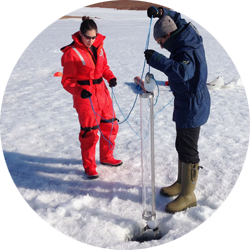 In the Milne Fiord epishelf lake, the viral community in the freshwater layer was distinct from, and more diverse than, the community in the underlying seawater and contained a different set of putative auxiliary metabolic genes. This is the first assessment of viral abundance, diversity, and distribution in this vulnerable ecosystem located on the coastal margin of the Last Ice Area (Labbé et al., 2022).
In the Milne Fiord epishelf lake, the viral community in the freshwater layer was distinct from, and more diverse than, the community in the underlying seawater and contained a different set of putative auxiliary metabolic genes. This is the first assessment of viral abundance, diversity, and distribution in this vulnerable ecosystem located on the coastal margin of the Last Ice Area (Labbé et al., 2022).
Only limited time remains to understand the biodiversity
Viruses are key to understanding polar aquatic ecosystems, which are dominated by microorganisms. However, studies of viral communities are challenging to interpret because the vast majority of viruses are known only from sequence fragments, and their taxonomy, hosts, and genetic repertoires are unknown. Rising temperatures in this region mean that researchers have limited time remaining to understand the biodiversity and biogeochemical cycles of ice-dependent environments and the consequences of these rapid, irreversible changes.
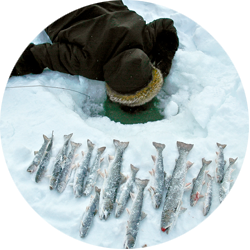 During the Qanuilirpitaa? survey and in partnership with Nunavik communities, the taxonomic and functional characteristics of the gut microbiota of Nunavimmiut youth were identified, revealing a composition distinct from non-Western and Western populations. Diet may explain the individuality of their gut microbiota (Abed et al., 2022).
During the Qanuilirpitaa? survey and in partnership with Nunavik communities, the taxonomic and functional characteristics of the gut microbiota of Nunavimmiut youth were identified, revealing a composition distinct from non-Western and Western populations. Diet may explain the individuality of their gut microbiota (Abed et al., 2022).
Diet, a determinant of intestinal microbiota
Changes in diet can unbalance the gut microbiota and lead to cardiometabolic disorders. It is important to be able to characterize the gut microbiota, to identify biomarkers and to develop predictive tools for a rapid and efficient diagnosis of cardiometabolic diseases.
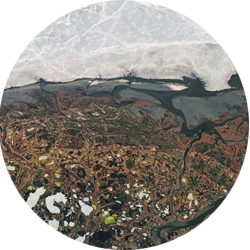 Significant progress in understanding carbon fluxes and greenhouse gas emissions has been made by Sentinel North teams, who are developing devices capable of detecting and quantifying gases released into the lower atmosphere due to permafrost thaw.
Significant progress in understanding carbon fluxes and greenhouse gas emissions has been made by Sentinel North teams, who are developing devices capable of detecting and quantifying gases released into the lower atmosphere due to permafrost thaw.
Optics and photonics to monitor greenhouse gas emissions in situ
- Remarkable advances have been made in the design of mid-infrared (2.5–5 micron) laser sources for detecting methane (CH4), a gas that exhibits strong absorption bands in these wavelengths (Jobin et al., 2022). Notably, research has shown that the concentration of a gas can be measured on a microphone using the photo-acoustic effect with a broad spectral band laser source.
- The first all-fibre laser operating in the mid-infrared range in the self-triggered regime using a dysprosium-doped silica fibre as a saturable absorber has been demonstrated. This laser could be robust and reliable enough to be deployed in extreme environments and detect more than one gas, including CH4, through its broad emission spectrum (Paradis et coll., 2022).
 Using Sentinel North articles published between 2017 and 2020, the interdisciplinarity of the research program was measured through the development of a new visualization approach. With this approach, the exceptional performances of the research teams in achieving interdisciplinary integration in their articles were captured.
Using Sentinel North articles published between 2017 and 2020, the interdisciplinarity of the research program was measured through the development of a new visualization approach. With this approach, the exceptional performances of the research teams in achieving interdisciplinary integration in their articles were captured.
Interdisciplinarity, a driver for impact research
A key objective of the Sentinel North program is to promote the integration of knowledge, methods and expertise from different disciplines to catalyze scientific discovery and innovation in support of sustainable health and development in the North. Thus, the convergence of expertise in the engineering, natural, social and health sciences can foster the kind of innovation and multifaceted knowledge needed to gain a holistic perspective on how climate change impacts are cascading through social-ecological systems and to develop adaptation strategies
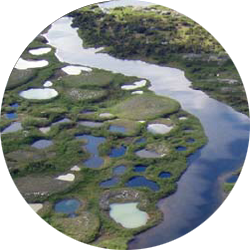 Combined with a 3D numerical model, field data provided key information on the processes governing groundwater flow and heat transport in and around a river-talik system in continuous permafrost areas, which could lead to a better assessment of the potential of talik aquifers as drinking water sources in northern communities (Liu et at., 2022).
Combined with a 3D numerical model, field data provided key information on the processes governing groundwater flow and heat transport in and around a river-talik system in continuous permafrost areas, which could lead to a better assessment of the potential of talik aquifers as drinking water sources in northern communities (Liu et at., 2022).
Changing hydrologic regimes
Rivers and groundwater in northern regions are impacted by environmental changes. For example, permafrost degradation causes an increase in active layer thickness and alters groundwater flow patterns. Understanding the underlying mechanisms is essential to better understand ongoing changes in permafrost environments.
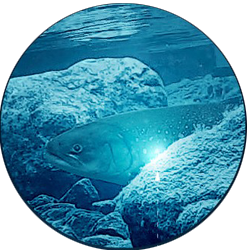 An unlikely mix of traditionally distant fields, the Design ta science! project showed that bridging disciplines can yield great results. The initiative, which brought together students from Sentinel North and from the School of Design, tackled complex subjects through self-supporting visuals intended for a non-initiated audience.
An unlikely mix of traditionally distant fields, the Design ta science! project showed that bridging disciplines can yield great results. The initiative, which brought together students from Sentinel North and from the School of Design, tackled complex subjects through self-supporting visuals intended for a non-initiated audience.
Interdisciplinary collaboration as a driver of innovation
Design ta science! is a convincing example of a cross-sectoral initiative based on convergence. In addition to having given birth to original creations capable of bringing research beyond traditional boundaries, the project was also the subject of a standalone conference and opening as well as an exhibition within the Quebec City library network.
 The Sentinel North Research Chair on the Relations with Inuit Societies has recently been standing out for its many participatory research initiatives focused on knowledge generation, capacity building and tangible benefits for Inuit.
The Sentinel North Research Chair on the Relations with Inuit Societies has recently been standing out for its many participatory research initiatives focused on knowledge generation, capacity building and tangible benefits for Inuit.
From governance to justice to health
Under the direction of Professor Caroline Hervé and with the support of more than 30 researchers, students and collaborators, the Chair has developed several projects, trainings and customized pedagogical tools, including:
- Organization of several workshops and talks with the aim of revitalizing Inuit legal practices
- A round table organized during the 22nd Congress of Inuit Studies in Winnipeg, on the theme of Inuit knowledge and research
- Setting up a participatory research project with the municipality of Cambridge Bay in Nunavut with the aim of increasing the community's food autonomy and allowing the transfer of knowledge related to the use of different indoor and outdoor growing systems.
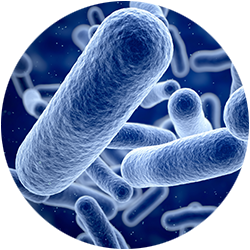 Thanks to genomics, a new type of interaction by which a primitive type of microbe (Archaea) attacks and pierces other microscopic cells has been identified. The article published in ISME Communications by postdoctoral biologist Adrien Vigneron opens the door to new hypotheses in the carbon and energy cycle in aquatic environments.
Thanks to genomics, a new type of interaction by which a primitive type of microbe (Archaea) attacks and pierces other microscopic cells has been identified. The article published in ISME Communications by postdoctoral biologist Adrien Vigneron opens the door to new hypotheses in the carbon and energy cycle in aquatic environments.
Answers at the bottom of the Arctic lakes
Under the direction of Warwick Vincent, the study is part of an effort to understand and anticipate changes in northern ecosystems. Drawing on genomics, biochemistry and microbiology, the discovery that originates from some of the northernmost lakes on the planet draws attention to the extreme complexity of processes governing Arctic food webs.

By establishing links between exposure to long-chain per- and polyfluoroalkyl compounds (PFAS) and the health of Inuit populations, post-doctoral researcher Amira Aker's work and that of northern communities is supporting Canada's efforts to include these substances on the list of banned products under the Stockholm Convention. Read the full article here.
Why legislate PFAS?
Long-chain PFASs are chemicals that fall into the category of persistent organic pollutants (POPs). They are transported by marine and atmospheric currents and are concentrated in the Arctic, where they are consumed by local populations through traditional food. These substances are associated with various health problems at the cardiometabolic, immune, hormonal and developmental levels.
A Sentinel North Postdoctoral Fellow pursuing her research projects with the Chaire Littoral, Amira is passionate about multidisciplinary research that integrates environmental and social stressors to better understand global health.

Caroline Menard and her team are paving the way for a revolution in the way depression and mood disorders are detected and treated. Results published in Nature Communications are the first to demonstrate the importance of neurovascular health in depression and to propose a new biomarker for its diagnosis.
Mental Health in the North
The North is undergoing significant socio-economic, cultural and environmental upheaval that is creating a unique form of stress in its populations. A better understanding of the neurobiology related to chronic stress, which is associated with vascular and immune changes, could lead to an innovative therapeutic approach that focuses on resilience and the whole body rather than just the brain.
The Sentinel North Research Chair in the Neurobiology of Stress and Resilience combines several areas of expertise and cutting-edge technologies, notably in optics and photonics, to focus on the interactions between the complex systems of the brain, neurovascular health, the immune system and the gut microbiome.
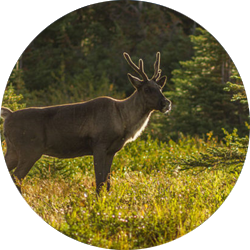 | The budworm makes life difficult for woodland caribouA team from Université Laval, the University of Saskatchewan and the University of Montana has shown that the spruce budworm is harming the recovery efforts of woodland caribou in Quebec by increasing their risk of being preyed upon by wolves in ecosystems that have been ravaged by the insect. Read more on Ulaval Nouvelles (in French) |
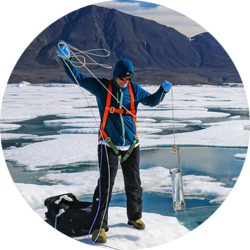 | Among leaders in microbiome researchSentinel North teams stand out for their cutting-edge work on the Arctic environmental microbiome and its impact on human health. Learn more |
 | Bioclimatic Design in the ArcticMaster of Architecture students win two awards in the American Institute of Architects' annual competition. This interdisciplinary success combines architecture, computer vision, civil engineering, mechanical engineering, acoustics and plant science.
Read more on Ulaval Nouvelles (in French) |
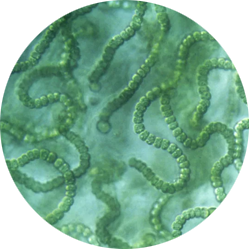 | Key Role of Viruses in Northern EcosystemsUniversité Laval researchers specializing in ecology and genomics, along with Anne Jungblut, a researcher at the Natural History Museum in London, have produced the first genomic portrait of cyanobacteria that play a key role in northern ecosystems, using state-of-the-art CRISPR-Cas technology.
Read the full news |
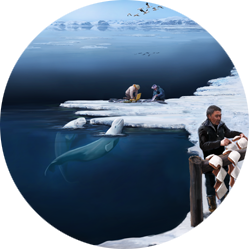 | Health-Environment Interactions in the NorthEarly results from Sentinel North are shedding light on the complex interactions between human health and the environment in the North through convergence research and the development of new approaches and innovative technologies. View the full infography |


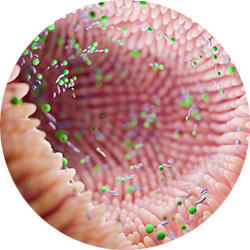
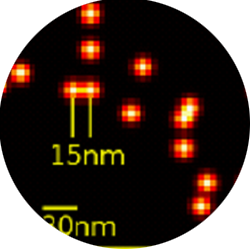
 Groups of genes have been associated with the expression of symptoms of major depressive disorder in both men and women. A better understanding of these transcriptional signatures will improve our ability to diagnose this disorder with greater accuracy.
Groups of genes have been associated with the expression of symptoms of major depressive disorder in both men and women. A better understanding of these transcriptional signatures will improve our ability to diagnose this disorder with greater accuracy.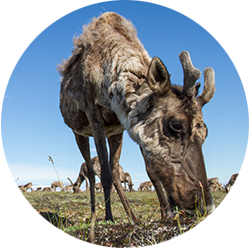
 The strategies that best mitigate human impact on boreal caribou are also the most effective in maintaining bird and beetle diversity, showing that single-species conservation management can be effective at preserving biodiversity in human-disturbed landscapes.
The strategies that best mitigate human impact on boreal caribou are also the most effective in maintaining bird and beetle diversity, showing that single-species conservation management can be effective at preserving biodiversity in human-disturbed landscapes.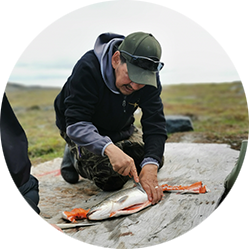
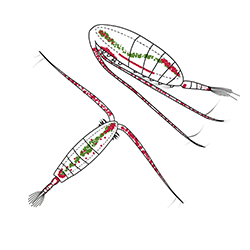 A new machine learning system has been developed to estimate the lipid content of copepods from in situ images. Faster and more accurate, this technology opens the door to a better understanding of how lipids are produced and distributed in marine ecosystems.
A new machine learning system has been developed to estimate the lipid content of copepods from in situ images. Faster and more accurate, this technology opens the door to a better understanding of how lipids are produced and distributed in marine ecosystems.
 Little studied in Arctic environments, the rapid production of volatile organic compounds has been measured in water samples from thawing permafrost. This process could affect the chemistry of the Arctic atmosphere, with global repercussions.
Little studied in Arctic environments, the rapid production of volatile organic compounds has been measured in water samples from thawing permafrost. This process could affect the chemistry of the Arctic atmosphere, with global repercussions.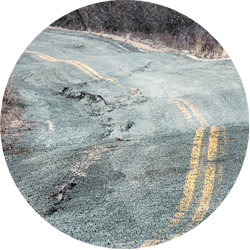



 A fast, portable and versatile biosensor developed by technology start-up DeteXion could enable diseases to be diagnosed more effectively, thanks to an innovative optical breakthrough. An original solution stemming from a northern issue, and that could soon have a global societal impact.
A fast, portable and versatile biosensor developed by technology start-up DeteXion could enable diseases to be diagnosed more effectively, thanks to an innovative optical breakthrough. An original solution stemming from a northern issue, and that could soon have a global societal impact. Culturally appropriate diets offer a new route to food security in the Canadian Arctic, according to
Culturally appropriate diets offer a new route to food security in the Canadian Arctic, according to  An international research team led by Sentinel North’s chairholder Pascale Roy-Léveillée has observed that the migration of large Arctic sinuous rivers in permafrost terrain has slowed down by about 20% over the past half century.
An international research team led by Sentinel North’s chairholder Pascale Roy-Léveillée has observed that the migration of large Arctic sinuous rivers in permafrost terrain has slowed down by about 20% over the past half century. A molecule with antiparasitic properties has been identified in the essential leaf oil of the Labrador tea (Rhododendron subarcticum), which could prove useful against parasitic infections, including malaria.
A molecule with antiparasitic properties has been identified in the essential leaf oil of the Labrador tea (Rhododendron subarcticum), which could prove useful against parasitic infections, including malaria. A breakthrough in the manufacture of gallium oxide, germanium oxide and barium oxide (BGG) glasses with exceptional mechanical and optical properties could help to better monitor the effects of climate change in the North.
A breakthrough in the manufacture of gallium oxide, germanium oxide and barium oxide (BGG) glasses with exceptional mechanical and optical properties could help to better monitor the effects of climate change in the North. In the Milne Fiord epishelf lake, the viral community in the freshwater layer was distinct from, and more diverse than, the community in the underlying seawater and contained a different set of putative auxiliary metabolic genes. This is the first assessment of viral abundance, diversity, and distribution in this vulnerable ecosystem located on the coastal margin of the Last Ice Area (
In the Milne Fiord epishelf lake, the viral community in the freshwater layer was distinct from, and more diverse than, the community in the underlying seawater and contained a different set of putative auxiliary metabolic genes. This is the first assessment of viral abundance, diversity, and distribution in this vulnerable ecosystem located on the coastal margin of the Last Ice Area ( During the Qanuilirpitaa? survey and in partnership with Nunavik communities, the taxonomic and functional characteristics of the gut microbiota of Nunavimmiut youth were identified, revealing a composition distinct from non-Western and Western populations. Diet may explain the individuality of their gut microbiota (
During the Qanuilirpitaa? survey and in partnership with Nunavik communities, the taxonomic and functional characteristics of the gut microbiota of Nunavimmiut youth were identified, revealing a composition distinct from non-Western and Western populations. Diet may explain the individuality of their gut microbiota ( Significant progress in understanding carbon fluxes and greenhouse gas emissions has been made by Sentinel North teams, who are developing devices capable of detecting and quantifying gases released into the lower atmosphere due to permafrost thaw.
Significant progress in understanding carbon fluxes and greenhouse gas emissions has been made by Sentinel North teams, who are developing devices capable of detecting and quantifying gases released into the lower atmosphere due to permafrost thaw. Using Sentinel North articles published between 2017 and 2020, the interdisciplinarity of the research program was measured through the development of
Using Sentinel North articles published between 2017 and 2020, the interdisciplinarity of the research program was measured through the development of  Combined with a 3D numerical model, field data provided key information on the processes governing groundwater flow and heat transport in and around a river-talik system in continuous permafrost areas, which could lead to a better assessment of the potential of talik aquifers as drinking water sources in northern communities (
Combined with a 3D numerical model, field data provided key information on the processes governing groundwater flow and heat transport in and around a river-talik system in continuous permafrost areas, which could lead to a better assessment of the potential of talik aquifers as drinking water sources in northern communities ( An unlikely mix of traditionally distant fields, the
An unlikely mix of traditionally distant fields, the  The Sentinel North Research
The Sentinel North Research  Thanks to genomics, a new type of interaction by which a primitive type of microbe (Archaea) attacks and pierces other microscopic cells has been identified. The article published in
Thanks to genomics, a new type of interaction by which a primitive type of microbe (Archaea) attacks and pierces other microscopic cells has been identified. The article published in 





